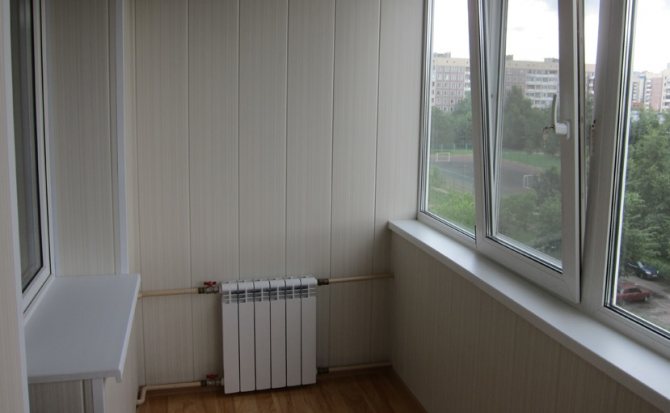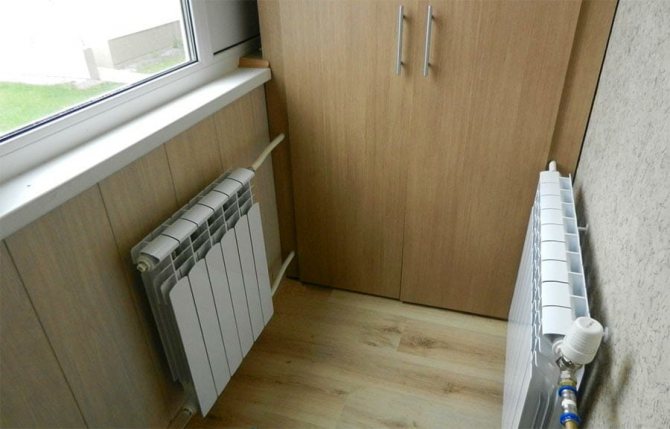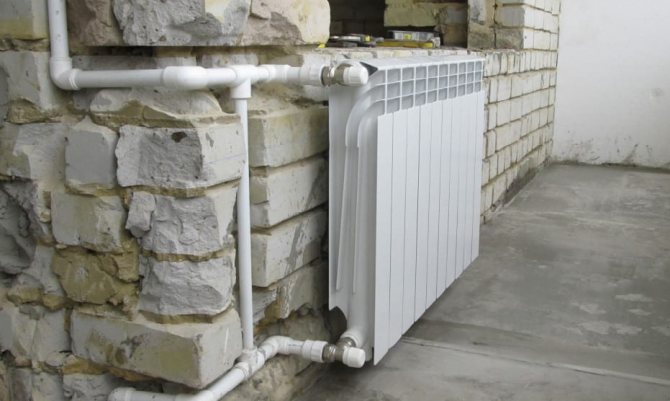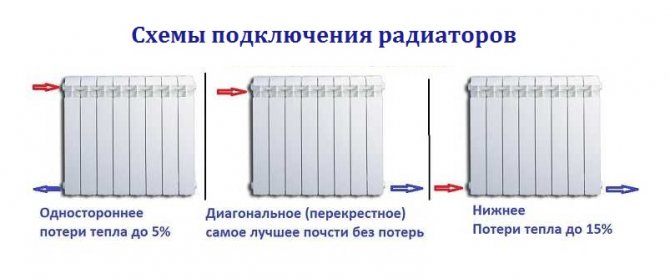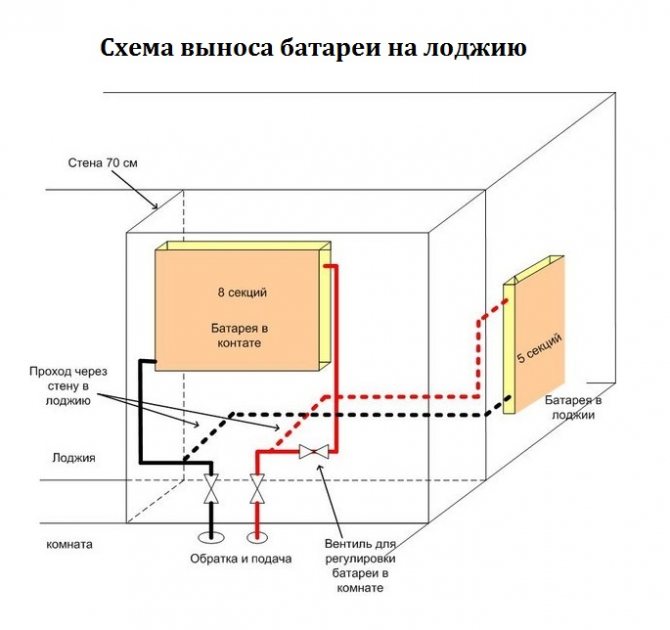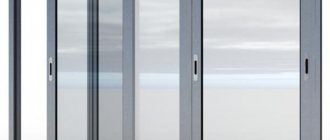So you can or can not take the battery to the balcony
In accordance with the Housing Code of the Russian Federation, article 15, paragraph 5, a balcony or loggia does not belong to a living space, and therefore rearrangement is prohibited here. At the same time, there are nuances that, with great effort, but still make it possible to legitimize the transfer of the battery to the balcony.
An unheated balcony never gets really warm, and therefore it will be almost impossible to use it as a living space. Insulation and glazing with metal-plastic profiles serve as good thermal insulation, protecting the space from cold air penetration into the interior and heat leakage to the street.
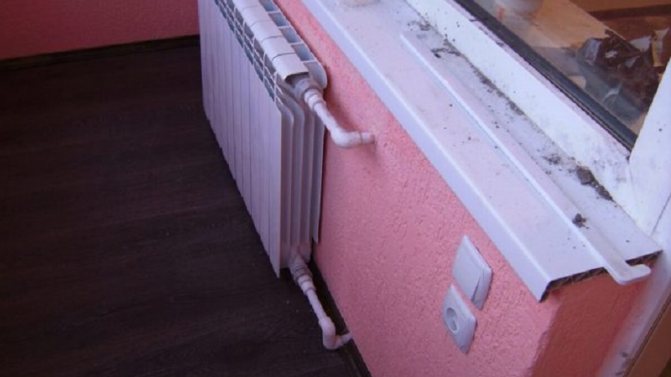
And here so that it is warm on the balcony or loggia at any time of the year, you need to think about heating... At this stage of the repair, many are just thinking about the soul-trembling question of whether it is possible to bring the battery to the balcony.
Interesting on the site:
Penoplex on the balcony: how to insulate the room yourself
What is izolon: types, features, material advantages
Why you can not install the battery on the balcony
Why it is impossible to take the battery out to the balcony, even if there is an urgent need for it:
- You can flood your neighbors on the floor below... In winter, when the outside temperature drops below zero, there is a risk that the heating battery installed on the balcony may freeze and "explode" under high pressure. In Moscow, even having insulated a balcony or loggia, they do not issue a permit to transfer the battery.
- Additional load on central heating... If you add one or more elements to existing radiators, the water pressure will weaken and lead to cold radiators throughout the house. So you risk not only getting a fine for the battery on the balcony, but also conflicts with your neighbors.
- Heating cost... The cost of a "communal" for central heating in the house is calculated per square meter for all residents of the house. Therefore, having made the output of the battery to the balcony, the price for heating will increase for all residents of the apartment building. If discovered, they have every right to take legal action and, with a high probability, win it. Of course, this fact can be hidden, but living in constant fear that deception will be revealed is stressful and risky.
- Problems when selling an apartment... When selling square meters, you must give the buyer a technical plan (technical passport), where, in addition to the layout, the thermal circuit is also indicated, which you changed by deciding to lead the battery to the balcony. There are two ways out - to return everything as it was, or to seek the legality of the removal.
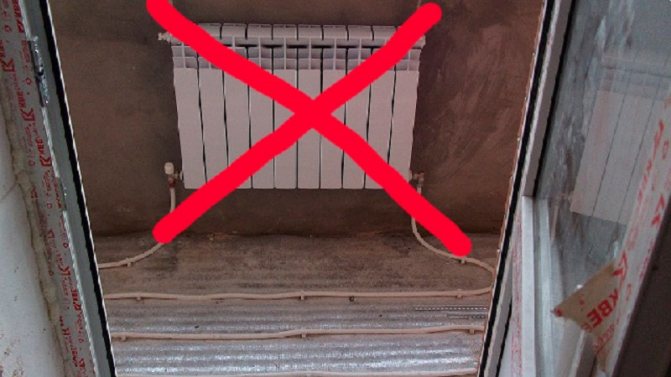

Theoretical part


Source: It goes without saying that battery removal should be done legally. If you install a battery on a balcony or loggia without proper approval, you may (and will) have problems if you suddenly want to sell or donate an apartment. The same goes for inheritance.
The fact is that for the sale / donation / transfer of real estate, a certificate from an engineer from the city bureau of technical inventory (BTI) is required.
Here is another important nuance: in the housing code of the Russian Federation there is article 25, and in it - paragraph 1. It states that the transfer of engineering communications is a reorganization of a dwelling. But the loggia and the balcony are not. This means that it is impossible to move the radiator there, that is, it is prohibited. And by the way, this is no coincidence. Here are some reasons why this is / is / is not the case:
- as a rule, water is supplied to the heating system by means of pumps. They, of course, have a certain power reserve, but if you add one or more additional units to the overall system, the pumps may not be able to cope. This will lead to a decrease in the pressure in the pipes and, as a result, to a catastrophic decrease in heating efficiency;
- but, suppose the pumps did the job. But an additional battery will increase the heat spreading area - already specifically in your room. Therefore, the water in the pipes will cool too fast. This means that the overall temperature in your apartment will drop by several degrees. I guess this is not what you want at all;
- due to unauthorized interference in the heating system, air jams may form, since the amount of water will be calculated exactly for the number of nodes that were originally installed in the house. But air jams can lead not only to a lack of heat in your or other apartments, but also to a local accident;
- if the balcony / loggia is not sufficiently insulated in all planes (walls / floor / possibly ceiling), the temperature in the cold season may drop below 0 ° there. Then the pipes can simply burst. Then both your balcony and the balconies of the neighbors below will be generously filled with water. Not the most pleasant prospect, is it?


Basically, there are two ways to achieve the desired result: on your own and with an intermediary. Now we will analyze in more detail what these solutions are, and then we will give a list of the necessary documents that will be useful to you in any case for approval.
Method 1. Self-settlement of the issue
This method is theoretically simple, but in practice it is incredibly complicated. The so-called "single window", where it would be possible to draw up all the necessary documents, alas, is not provided. Therefore, you will have to walk around the offices of the city administration to complete the necessary papers.
Method 2. Settlement through an intermediary
There is no need for you to take active action here. You can contact an organization that can help you settle the case with little or no involvement. But, of course, it will help - not for free. The prices for different companies providing such services may differ, so here we will not give specific amounts. In addition, in specific cases, these amounts may differ.
In working through an intermediary, everything is much easier: you provide a package of necessary documents, draw up a contract for the provision of services, pay the amount specified in the contract - and just wait until the office does the work for you.
But be careful when choosing an office, as there is a great risk of getting into an dishonest company. Check her reputation if possible. Find reviews about her work in other sources (Internet for help), read reviews of people who have already used their services, check from what year the company has been providing services. The older she is, the higher the likelihood that the business will go well and you will not be left with a nose.
Finding such an office will not be difficult. Just write in the search box Yandex or Google the query "how to carry out heating on the balcony of the agency" or "how to legalize the transfer of the battery company." You can add the name of your city to the request - Moscow / St. Petersburg / Arkhangelsk ... The search engine will first of all give you several landing-page (landing page) companies that are ready to help you. Moreover, with a focus on your locality. But, again, do not rush to contact the first one that comes across. Analyze and compare several options, compare prices for services, and only then draw a conclusion.
Documents
Please note that this list of documents may not be complete. This article was written in 2020, and laws tend to change.Not drastically, of course, but you may have to add something else to this list. Most likely, this is some kind of additional help, which will not be difficult to obtain.


- A document confirming your right to an apartment (contract of sale, donation, inheritance / privatization certificate).
- Consent of residents who have reached the age of majority to remodel the living space. The document must be certified by a notary, but this can also be done at the housing maintenance office.
- Technical passport. In this case, the inventory period should not exceed one year.
- Sketch. In the event that the battery has already been taken out - and you are settling retroactively - you will need to take a photo of the fruits of your "initiative".
- Consent to work from the neighbors from above.
- Passport and its copy.
- Identification code with copy.
With this set of documents, you can go to the BTI or the appropriate agency. We figured out the procedure for legitimizing our actions. Now let's talk about the practical part of the work, that is, we will find out how you can physically transfer the battery.
In what cases can you legally lead a battery to the balcony
In case of obtaining permission for redevelopment and the status of the living space on the balcony or a loggia.
Important! It is possible to lead the battery to the balcony, while not violating the legal framework, but with great effort and time consuming. If you are ready for this, then I will tell you how to do it.
To transfer the heating radiator to the balcony it is imperative to obtain permission from the housing inspectorate... And it doesn't matter if you take out the old one, or are going to put a new element into the heating system. If you start dismantling a radiator and installing a new one without getting permission, you are already breaking the law.
We would like to note that this procedure is a bureaucratic problem that can last for more than one month.... If at the same time repairs are made, it will stretch, which is very unpleasant. Therefore, I often meet cases when they first install a radiator on the balcony, and then they seek permission. But I want to note that there is a high probability that they may refuse to receive.
Before you go and ask for that very permission take care of making accurate calculations... You should have in your hands accurate calculations regarding the number and size of sections, their location, pipeline pressure and temperature. You cannot do this yourself without the proper skills, so you need to contact professional designers. Such an extensive collection of information for the BTI will testify to the safety of your decision to bring the radiator to the balcony, and therefore the likelihood of getting the "go-ahead" is higher.
Before putting the battery on the balcony, it is necessary to make insulation... Without it, it is impractical to make a transfer, since on a cold loggia all the warm air will go out into the street, moreover, in this case, you will not be able to prove that the temperature on the balcony in winter will be acceptable for installing a battery.


Documents for obtaining permission:
- Calculation of thermal conductivity.
- An official conclusion from experts, which confirms that the water in the battery will not freeze.
- The developed planning project - you can contact the design company.
Depending on the region where you are going to install the radiator on the balcony, the housing inspectorate can modify and add an additional list of papers.
Note! In order not to delay the repair, some decide to put the battery on the balcony without obtaining the notorious permission, but only after the completion of the installation work, begin to do the decoration. I warn you, this is risky, because there is always a possibility that the BTI services may refuse a decision.
On the net and in various forums, you can come across the advice of the owners of such apartments, who decided that it is possible to install a battery on the balcony without any documentary problems. They say they live for 10 years and even manage to sell. We would like to especially note, firstly, you should not listen to anonymous users who are not responsible for what they have written (very sorry), and secondly, approach your situation individually, because you will never know what and how others actually had there. Maybe:
- their heating system is not central, but individual;
- neighbors do not mind or they do not care about what is happening there in the apartment of others;
- "The hour has not yet struck" and the detection of illegal planning remains a matter of time.
Advice! Think with your own head, reading such recommendations, and remember that if something happens, you are responsible for what you have done, and not anonymous Internet users.
Installation of the heating system on the balcony
This kind of work is carried out in the summer when the heating is turned off.
It is quite difficult to independently transfer a heating radiator to a balcony or loggia; it is better to entrust this process to professional plumbers. Those who decide to do it on their own need to use the following materials and tools:
- Mayevsky crane;
- shut-off and regulating valves;
- plugs;
- foot nuts;
- tape measure;
- grinder;
- pipes;
- perforator;
- in a vice;
- dice;
- welding machine;
- sealant.
Initially, a scheme is being developed according to which the connection will be made. In any case, a jumper must be used. It will allow you to prevent the occurrence of problems with neighbors, even if the installation is carried out with the heating system turned on.
Stages of work


Instructions:
- Installation is carried out to the main heating pipe. For this, an incision is made with a grinder. After that, the external thread is cut on the pipes and fastened. A branched fitting is used for the connection. Important: when connecting pipes and parts, it is necessary to use waterproofing. It can be tow or fum tape.
- Pre-puncher drills holes in the wall through which pipes are pulled. On the outside they must be carved. If the radiator will be located on the wall of the house, then the pipes should extend to a distance of up to 10 cm. If on the side wall of the balcony, then it is necessary to extend them further by turning with the fittings.
- In the place that was planned for placing the battery on the balcony, one pipe is placed vertically with an angle fitting.
Next, the radiator is hung up.
Installing the radiator
The first step is to prepare the attachment point. It is recommended to install foil or similar heat-reflecting material on the wall so that the heating works inside the room and not on the walls.
- Fixation points are outlined. Brackets are installed on them. If the heating radiator is cast iron, then they must be anchor and reinforced.
- Installation of fastening systems is carried out using a perforator, while the walls must be fully prepared.
- The radiator is hung on the fixing elements. Installation is carried out using bolts and nuts, rubber washers are laid for structural reliability.
- The uniform position is checked with a building level.
- The eyeliner is connected. For this, 2 pipes (25-30 cm) are diverted from the radiator. One of them will be connected to the heating system. The other will be closed with a fitting.
- The pipes for the water supply and outlet are screwed into the existing fittings. The joints must be waterproofed and covered with a sealant.
There are some general rules to be followed during installation.
General recommendations
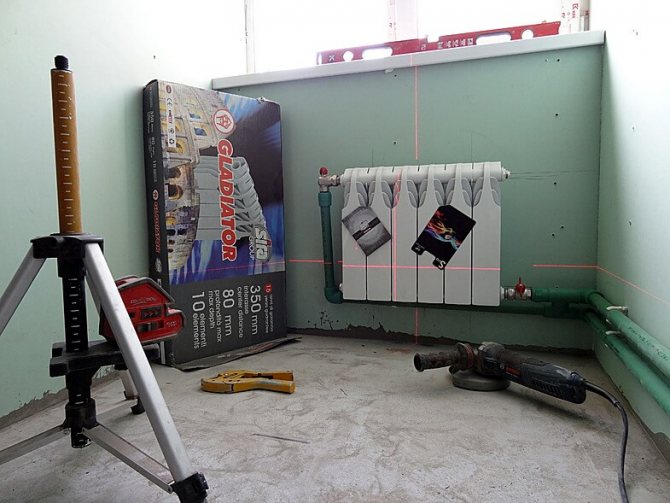

When taking out the battery to the loggia:
- 2 brackets are used. One is located higher, the other is lower relative to the radiator.
- He himself should be no further than 4 cm from the wall.
- There should be at least 10 cm from the window sill, and 12 cm from the floor.
The best option for installation would be plastic pipes. They are easy to install and are soldered to the fittings.
What does the law say about the removal of heating radiators
If, despite the fact that you have fulfilled all the requirements and there are no good reasons for refusal, but you are still given a negative answer, be prepared to defend your position... And for this it is necessary to be well versed in the bills that regulate this issue.
Important! Study in detail these 2 provisions of the Housing Code of the Russian Federation: article 25, paragraph 1 and article 15, paragraph 5.
Briefly about the essence of these regulations:
Article 25, paragraph 1: "Types of reconstruction and redevelopment of premises in an apartment building" states that it is allowed to replace and transfer engineering networks, which include heating. But at the same time, there is a note regarding this condition of residential areas. "
Article 15, paragraph 5: "Objects of Housing Rights" regulates the procedure for recognizing premises as residential. Therefore, it is important here to prove that the loggia or balcony, after redevelopment and integration with the living room, also became part of the living area. "


The main stages of installing a heating radiator on a loggia:
- Calculations of thermal conductivity and the conclusion that the radiator outside the apartment will not freeze.
- Redevelopment project and technical opinion from the author of the house about its possibility.
- Obtaining permission from city authorities.
- Changes to all documents for the apartment.
- Battery installation.
The most crucial stage is a redevelopment project with a change in the status of a non-residential premises to a residential one, after which - a technical conclusion. If a conclusion can only be issued by the author of a house project (usually a design institute), then a project can be developed either by a specialized organization or by the same institute. At the same time, the requirements of the standards - building, sanitary and fire safety - must be fully taken into account, and engineering calculations must be carried out. The last one - after you have completely insulated the loggia and calculated all the risks.
The conclusion can be issued only if the redevelopment (in our case, the transfer of the radiator) does not affect the state of the house. In old houses recognized as architectural monuments, it will be very problematic to install a battery on a loggia, but in new buildings the chances of modernizing your balcony are much higher.
Then the project documentation is drawn up. After all these tedious procedures, you need to coordinate the project with Rospotrebnadzor, fire supervision, the Directorate of a single customer and a number of other departments, and obtain permission to install a balcony battery from the city housing inspectorate.
After all - to approve the apartment redevelopment in the BTI, amend the title documents and install equipment in the now residential premises with a calm heart.
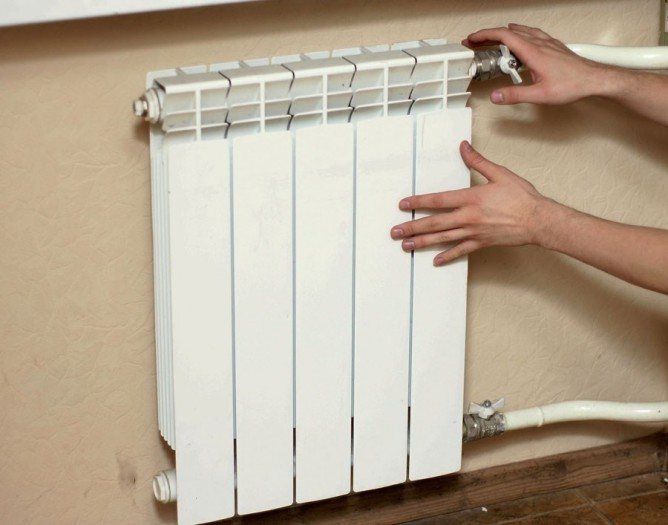

The battery installation project must be agreed with the relevant authorities
Penalties and fines in 2020 for taking out the battery
Illegal redevelopment entails penalties, and taking the battery out onto the balcony and making the loggia part of the living space without permission is just one of illegal actions on your part.
If found, a fine for illegal redevelopment, including for the battery on the balcony, in 2020 in Moscow and the region was:
- for individuals - 2500 rubles;
- for legal entities - 70,000 rubles.
Paying a fine is not the only punishment... After that, you will be forced to return everything back. And therefore, in addition to the costs of the fine, you will have to spend money on dismantling. In this case, you can challenge the decision and submit to the court an application with the evidence provided that such a redevelopment with the removal of the radiator to the balcony does not pose any danger or any inconvenience to the residents of the house.As a confirmation of this, it is necessary to collect the signatures of all neighbors. After that, the court makes a decision either on the legality of the repair or on dismantling.
How to legally formalize the removal of the heating battery
You should be aware that unauthorized mounting of the heater on the balcony is prohibited by law. For spontaneous actions, the owner of the apartment may be subject to an administrative penalty in the form of a fine, with the subsequent obligation to legalize or dismantle the transferred heating equipment. After all, the presence of a new radiator entails an additional load on the common building riser that supplies the neighboring batteries with coolant, creates a threat of a breakthrough in the system when low temperatures come.
As a result, the new battery on the balcony, which was not previously included in the thermal circuit of the apartment, will increase the cost of utilities for the residents of all apartments located on the riser. In the event of an accident, it will be necessary to compensate the injured persons.
Therefore, before you carry out the removal of the battery to the balcony, you need to prepare and receive at the appropriate institutions:
- technical conclusion;
- redevelopment project of the premises;
- battery installation permit.
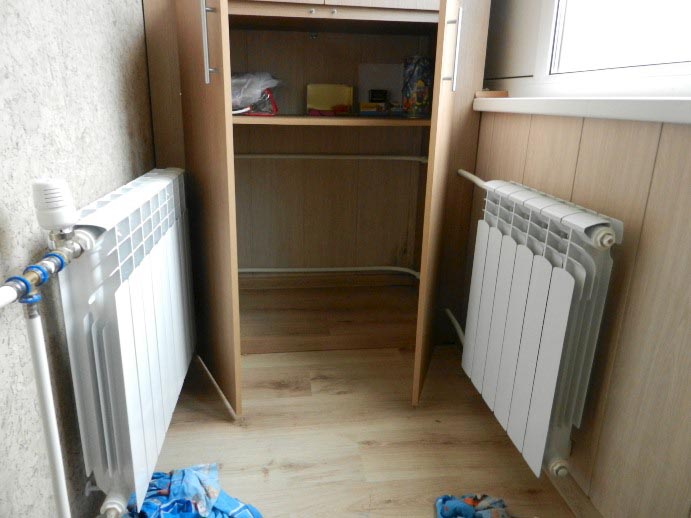

Before starting action, it is necessary to study regional legislation, which at the local level may prohibit the removal of heating devices even on insulated balconies.
For a technical conclusion, an assessment of the suitability of the insulation of the loggia allocated for the installation of the radiator by the specialists of the authorized construction organization is needed, who will then issue a conclusion about the possibility of installing the heater on the balcony of the apartment and the absence of the threat of an accident.
Subsequently, a specialized organization, in accordance with construction, fire-prevention and other specialized norms and rules, prepares a project that is coordinated with the territorial divisions of Rospotrebnadzor, the Ministry of Emergency Situations and some other control and supervisory bodies. Permission for the installation of a balcony radiator is issued by the housing inspection of the settlement. The final stage of the procedures should be the approval of the redevelopment and the new technical passport of the living quarters in the BTI. Having the documents in hand, you can fearlessly begin to remove the radiator from the room to the balcony, and also subsequently sell the re-planned apartment, if necessary.
Thus, the preparatory process for the official transfer of the battery to the balcony or loggia is time consuming and laborious. Less expensive are air conditioners, various heaters that do not require special permits for installation.
Owners of private houses can carry out this type of work with complete peace of mind.
Sequencing
Important! First of all, it is necessary to thoroughly insulate and install double-glazed windows!
So, legal and technically correct sequence of actions if you want to place a heating radiator on the balcony, it consists of the following steps:
- insulation of external walls;
- reconciliation of redevelopment, obtaining appropriate permits and conclusions;
- selection of the optimal type of radiator and installation method;
- wall preparation - installation of thermal insulation, finishing;
- direct installation.
If you are firm in your intentions, then for apartment buildings, it is recommended to precisely transfer the radiator from the room to the balcony, and not to install an additional, which will immediately significantly reduce the efficiency of the common house system - this is unlikely to please the neighbors and will entail checks.


Legality of the event


It is not necessary to take the radiator out to the loggia. you can increase the heat output of an existing one.
According to the law, the removal of the battery to the loggia is allowed only if this is agreed with the service organization. That is, you must apply to your housing office with a statement in the prescribed form. The staff will consider it and, most likely, the case will stop there. Indeed, it is extremely difficult to legalize this event.
Why are they not allowed to take out radiators to non-residential premises:
- overrun of the coolant;
- violation of the project;
- imbalance in the heating system.
For the transfer to be legal, you first need to redo the project of the apartment, adding the loggia to the living area.
To do this, you need to call the commissions, hire designers, coordinate everything in the appropriate authorities. Then, you need to redevelop the heating system. The heat loss of the room, which has already changed, the volume of the circuit, its hydraulic resistance must be taken into account.
There are cases when the heat exchanger is taken out of the dwelling at your own peril and risk, without legitimizing this event. We would like to warn you that such actions are suppressed by the workers of housing offices, and those caught are fined and forced to return everything as it was according to the project.
There is not a central gas pipeline everywhere, so stove heating of a house in a village is still relevant.
About what convection ovens for heating a house are written here.
Preparing for installation
Preparatory activities include several mandatory stages.
Radiator selection
You need to choose the type of radiator based on its technical characteristicsthe most important of which is the working pressure. It must correspond to the limits of the pressure drops in the heating system of the house. As a rule, in old five-storey buildings the value of this indicator is 6 - 8 atmospheres, and in multi-storey (10 - 14 floors) the pressure level already reaches 12 - 15 atmospheres.
The second important indicator is resistance to water hammer.... The service life of the radiator and the quality of heating depend on this characteristic. With a centralized heating system, it is almost impossible to avoid water hammer, therefore, when choosing equipment, you need to pay attention to this technical characteristic. Additional factors of importance include life, ease of installation, and design of the radiator.
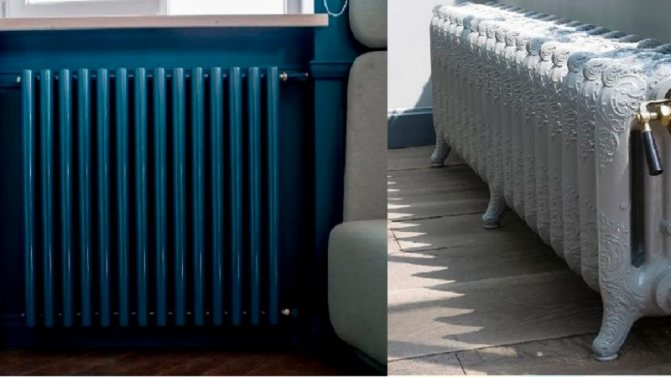

Radiator types
The types of batteries and radiators are divided by classes and materials of manufacture:
- Cast iron. They have the longest service life (up to 35 years). The main disadvantage is long heating and cooling.
- Steel panel. They will last about 15 years. They are appreciated for their high heat transfer rates and other technical characteristics, as well as their low cost.
- Steel tubular. They are produced in various colors and designs, which allows you to choose them for any interior. They have excellent consumer properties. The disadvantages include high cost.
- Aluminum. Average service life 15 - 20 years. They are characterized by high thermal conductivity and low weight. The main disadvantage is the sensitivity to PH of the filler, therefore it is recommended for private houses with an autonomous heating system.
- Bimetallic. The best option for an apartment, since they are unpretentious to the composition and quality of water, have good heat transfer, and are resistant to water hammer.
Calculating the number of sections
All types of radiators are composite, so you can select the number of sections required to heat a particular room, depending on the area.
The calculation must be made on the basis of generally accepted standards.:
- one aluminum section for 2 m2;
- one bimetallic section of 1.5 m2;
- add 1-2 sections for reinsurance.
Choosing a connection option
You can consider such connection methods:
- Side. The most common mounting method. The inlet and outlet pipes are mounted on one side of the radiator. The main requirement is to observe the distance between the fittings, otherwise the radiator will not warm up enough.
- Lower. With this option, both pipes are mounted at the bottom of the radiator - inlet on one side, outlet on the other. The main disadvantage is low heat transfer.
- Diagonal. The inlet is mounted on top on one side of the radiator, and the outlet on the bottom on the other. With this method, the least heat loss is achieved, therefore it is considered the best.
Which pipes to choose
For works it is recommended to choose reinforced polypropylene pipes, because they:
- bend easily, which allows installation of any complexity;
- do not deform during operation;
- do not require welding - flux is applied to the joints and sealed with a special blowtorch;
- have a high heat transfer coefficient.
It is possible to use copper pipes, but this is a more expensive and difficult-to-install option. Ordinary propylene products quickly deform and lose their attractive appearance.
Types of water heating radiators
To decide how to heat the balcony, first of all, you need to choose a radiator that is suitable in terms of quality and aesthetic characteristics. The variety of models largely depends on the manufacturer. Only taking into account the material used for their manufacture, four types of radiators can be distinguished. Consider the advantages and disadvantages of each type of device:
- Cast iron models - amazingly, many manufacturers continue to make them today. True, they have a more modern and attractive appearance; often a protective decorative screen is offered with them. Their main advantage is simplicity in operation. They are not afraid of rusty water and other adverse environmental factors. But it must be borne in mind that cast iron has a low thermal conductivity. This is the main disadvantage of such heating devices.
- Aluminum radiators are the main object for designers to improve the appearance of heating devices. They will perfectly fit into the interior of the balcony. Their model range is very rich, so you can choose a radiator taking into account the taste of any consumer and his financial capabilities. But they are "afraid" of various harmful impurities in the incoming water - this is their main drawback. They can damage the oxide protective film inside the battery, which cannot be restored without oxygen. This will significantly reduce their service life.
- Steel radiators are available in two types: tubular and panel. Panel-type heating devices are cheaper than even their aluminum counterparts. They differ in a rather simple design, but rather high heat transfer. In the development of models of tubular steel heating devices, the designers of the manufacturer's company take a large part. Therefore, installing this type of battery on the balcony will harmoniously complement the interior.
- Bimetallic radiators are the most practical option for a heating device. It is an original steel structure with aluminum spraying. Due to this, they have high thermal conductivity and a long service life.
Alternative solutions for balcony heating - heaters
When it comes to heaters on balconies, apartment owners are skeptical. - high power consumption, heat up for a long time, ineffective.
This was so even 5 years ago, when basically it was possible to purchase only a fan heater, popularly called "wind blower". They really consumed a lot of electricity, and after they were turned off, the room cooled down again.
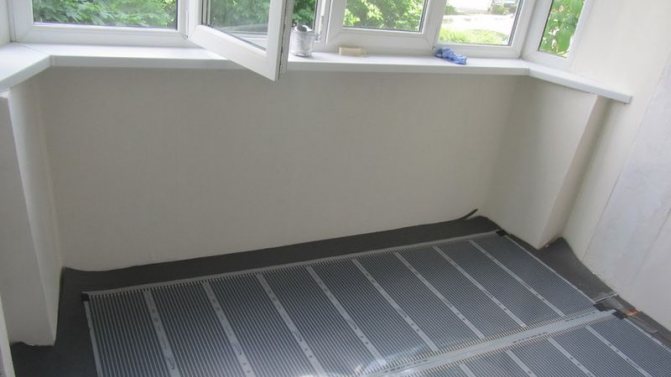

With the advent of infrared heaters, the situation with heating on the balcony has changed significantly for the better.... They quickly heat up the room, consume little energy, are safe to use, they can be left on overnight; when the required temperature is reached, the system automatically turns off the device.If, in addition to such a heater, you install a warm floor, you can spend time in complete comfort on your balcony. Regardless of the temperature outside the window.
Another alternative to bringing the radiator to the balcony is to connect a solar panel. Let's dwell on this option in more detail.
Alternative to taking out the battery to the loggia


Heating the loggia with a warm floor.
You can not take the battery to the loggia, but increase the radiator in the adjacent room. It's easier to arrange. If it is extremely important for you that there is some kind of heating on the insulated balcony, then we recommend that you look towards the electric warm floors.
There are several types of them:
The cable can be run in one wire, or it can be glued in zigzags to fiberglass rolls. The cable underfloor heating must be laid in the screed layer, of course, having previously insulated the floor. It is allowed to lay the cable on the grid under the tiles. Infrared films are placed under linoleum or laminate flooring.
You will definitely insulate the floor on the loggia, so the heating elements need to be laid already at this stage. It is important that the cable does not come into contact with the thermal insulation. The screed layer should be at least 5 cm. The thicker the screed, the more inert the heating - this is convenient, the floor does not cool down so quickly, and the heater turns on less often.
IR films for underfloor heating are a good option when all the work has already been done.
By the way, they are the cheapest, but they have disadvantages:
- saving infrared floor heating is a myth;
- heating elements are connected to a network without grounding through an RCD.
If the underfloor heating option does not suit you, then only an electric heater remains. Naturally, the more compact the better. IR heaters and convectors are most commonly used, while ceramic or oil heaters are less popular.
Solar panels for an apartment on the balcony
The ability to use alternative energy sources is a popular and interesting topic. Solar panels are one of the solutions that are most in demand in regions with frequent power outages in residential buildings.... They can even be installed on small balconies of city apartments. Of course, such an installation cannot replace the traditional power grid, but you will always have the opportunity to charge your mobile phone and light up the room.
The solar cell includes the following elements:
- Photocells. Generates an electric current when exposed to sunlight. They are plates of semiconductor material (polycrystals or single crystals of silicon, amorphous silicon, cadmium telluride, CIGS), which can be connected to each other and form panels of different sizes.
- Battery. Allows you to accumulate energy and use it as needed.
- Inverter. Converts DC battery current to AC current.
- Control system.
- Additional equipment with USB and other types of outputs for direct connection of gadgets, table lamps and small appliances.
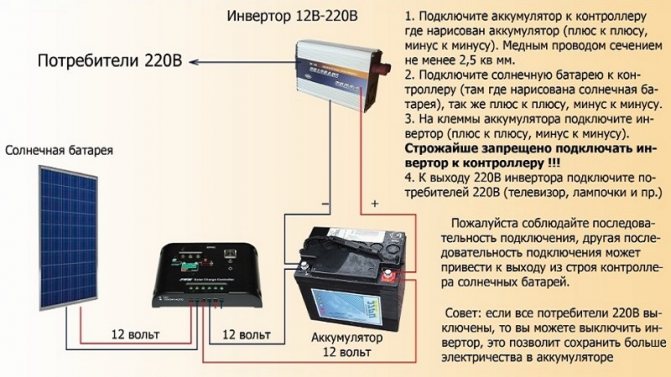

Solar cell efficiency
According to user reviews, a balcony system of 4 panels is capable of generating up to 2 kW of electricity per light summer day... This is enough for lighting the apartment with energy-saving lamps, recharging a mobile phone and, possibly, for the operation of some household appliances.
For the full use of all equipment (washing machine, water heater and stove), the current generated by the balcony solar system, of course, is not enough. In winter, system performance is 3-4 times lower.
Economic expediency
The cost of a branded factory installation for a complete household use starts at RUB 250,000 It is clear that the payback period in the middle latitudes of Russia will be very long. Chinese counterparts are much cheaper.
The system can be assembled with your own hands from componentsordered on AliExpress. According to the masters, a home-made design, made with an appropriate level of quality, costs no less than a ready-made battery from China, but this approach will be of interest to creative people with an engineering mindset.


Installation features and basic requirements
Installation of solar panels on the balcony does not require approval, provided that the design does not interfere with neighbors and does not create a potential hazard. The exception is houses that are architectural monuments in the historical part of the city - in this case, changing the appearance of the facade is possible only after obtaining permission.
In order for the solar panel on the balcony to work efficiently, installation rules must be followed:
- Select the correct location for the battery. It makes sense to install systems only on the south or southeast side. In addition, you need to make sure that they will not be shaded by neighboring buildings, trees and structures - a shadow covering only one element reduces the efficiency of the entire system by 2 times.
- The balcony should be glazed and insulated, as the battery quickly loses its charge in the cold.
- In the case of an open balcony, it is necessary at least to provide protective boxes that protect the equipment from moisture and pollution or place it in the living room, which is inconvenient and environmentally unfriendly.
- In Russian conditions with a small number of sunny days, it is recommended to use polycrystalline photocells - they are more sensitive even to a weak luminous flux.
- A solar cell works most efficiently when the rays strike it at a 90 degree angle. Therefore, ideally, the system should not be strictly vertical, but at an appropriate angle and be able to adjust following the deflection of the sun throughout the year. In the conditions of a city balcony, this is quite difficult to implement.
How to assemble a solar panel with your own hands
To assemble the panel yourself, you need the following materials and components:
- glass;
- photocells;
- aluminum profile for the frame;
- sealant;
- conductor (you can use a twisted-pair copper Internet wire).
- From the tools you will need a 40 W soldering iron and a multimeter.


Sequence of work:
- Calculate the area and size of the glass so that all the photocells fit on it, taking into account the gap between them of 3-4 mm.
- Cut the aluminum profile at a 45 degree angle. Assemble the frame of the future battery.
- Cut the conductor to the desired length. Start soldering the photocells. This stage requires special care and attention, since silicon wafers are very fragile (you can buy already soldered photocells and skip this stage). Cover the soldering points with an alcoholic solution of rosin and tin. Strip the wires from insulation, tin and lightly solder at several points. Then solder thoroughly along the entire length.
- Carefully check the operation of each element under load. If at least one defective element gets into the overall system, then the battery performance will be significantly reduced.
- Connect the cells to each other. First, you need to sequentially collect two independent links. Then lay them on the glass and connect them in parallel. The parallel-serial connection provides the highest system efficiency.
- Bond the photocells to the glass with silicone sealant.
- Place the workpiece in the aluminum frame and also glue.
- Cover the back of the battery with a second layer of glass. Seal the joints.
- Connect the battery with other elements of the system and install it on the balcony.
When it becomes necessary to transfer the battery to the loggia
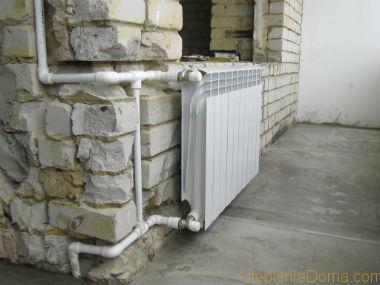

It is forbidden to move the radiators of the central heating system outside the residential premises.
The question of transferring the battery to the loggia arises only if it is connected to the living area.This is practiced quite often. Basically, it is combined with the kitchen. Naturally, the first is high-quality glazing and external insulation of the loggia.
But even after that, the temperature in the common room will drop noticeably, so it is necessary to increase the heat output of the heating system. Simply taking the battery out to the balcony will not solve anything if the radiator is not powerful enough. You need to either install more sections, or just add another heat exchanger.
If you look at the issue of transferring the battery to the loggia only from a technical point of view, then you can highlight the following important points:
- installation of double-glazed windows with a thickness of at least 70 mm;
- it is advisable to apply a special coating on the glass, which reduces heat loss;
- insulation of the loggia from the outside - the thickness of the insulation is preliminarily calculated;
- insulation of the floor and ceiling of the loggia from the inside;
- in proportion to the heated area, the heat output of the radiator must be increased.
Unfortunately, it is very difficult to get permission to take out the battery to the balcony so that everything is legally difficult.
Today, not everyone can afford electric heating in a wooden house. But those few who are heated in this way know how convenient it is.
Read about the installation of heating in a wooden house here.
Types of batteries for balconies and loggias
After you are allowed to install heating devices in your newly acquired living space, you need to choose the optimal type of radiator. Heating appliance manufacturers offer the following options to homeowners:
- Steel batteries - they are inexpensive, but they do not have thermal inertia and high thermal conductivity. The main advantage of the option is the ability to withstand the highest pressure (up to 20 atmospheres).
- Cast iron radiators - they have an average cost and high thermal inertia, service life up to 50-70 years.
- Aluminum and bimetallic (steel pipe and aluminum fins) batteries - they have the highest heat transfer coefficient, so they squeeze all the calories out of the coolant.
If you want to build inexpensive and reliable heating, choose steel. But if you need to get the maximum temperature for the same money in utility bills, order the installation of a bimetallic radiator.
